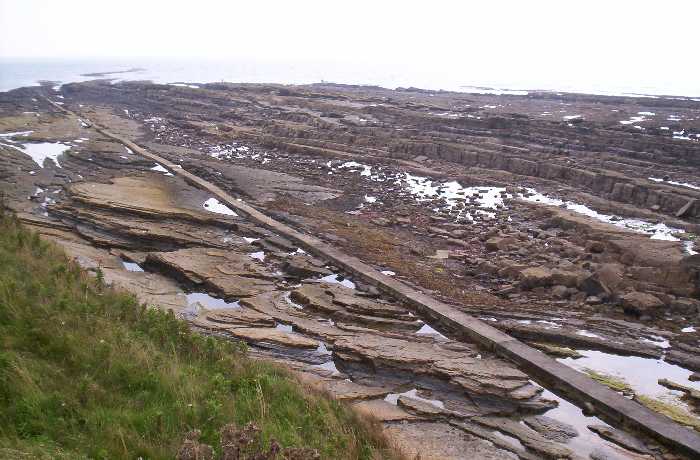
SAFETY must be your over-riding first concern. The current score is one air-ambulance evacuation from this area of a casualty with orthopaedic injuries in each of two recent years.
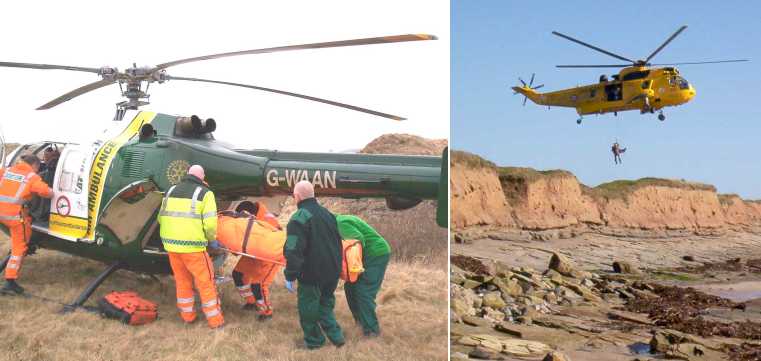
Follow the Coast Path from above Seahouses harbour, southwards towards Beadnell. You'll skirt round a mobile home park and then make your way along the edge of some major cliffs - home to nesting gulls and kittiwakes in due season. Then the path takes you across a part of Seahouses Golf Course and back down towards a rocky/pebbly section of beach: that is Snook Point on the Ordnance Survey map, at grid reference NU226315 (55° 34' 36" N, 001° 38' 26" W).
Seashores provide perhaps the most compactly varied ecosystems anywhere in the world. Over a range of a hundred or so metres in distance and less than a dozen vertical metres a range of self-contained communities blend systematically into each other and their surroundings. The facility at Snook (or "North Sunderland") Point is a concrete path protecting a storm drain (not a foul sewer!): it provides much the easiest and safest access route to the full range of littoral zones.


Dry rock which sparkles (sandstone) is usually safe. So too are any rocks liberally colonised by barnacles -
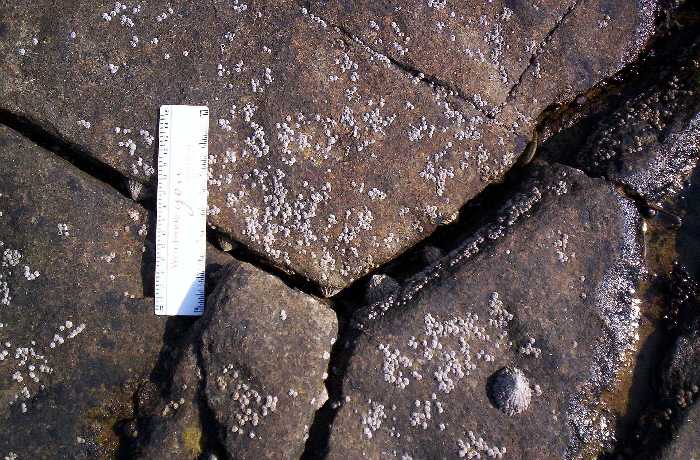
But rounder shells are remarkably strong too and can act like ball-bearings -
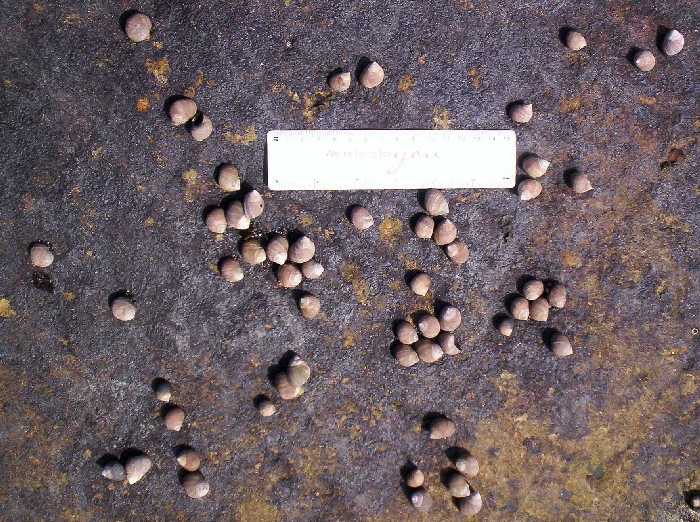
- while anything even remotely weedy is bound to be slippery -
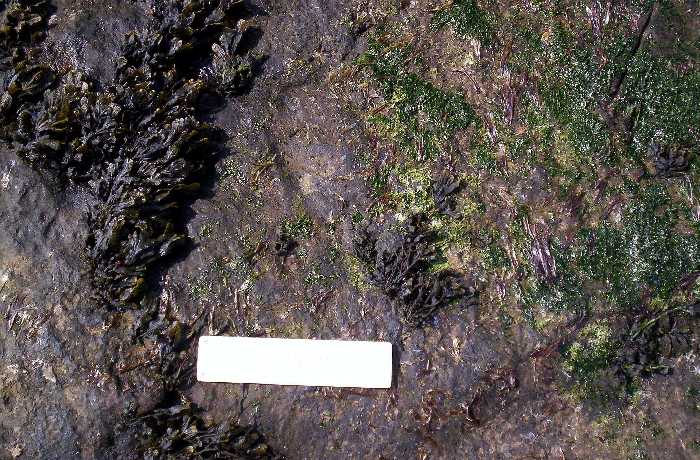
- and beds of seaweed are more treacherous than ice - just as slippery but hiding all the bumps and hollows.
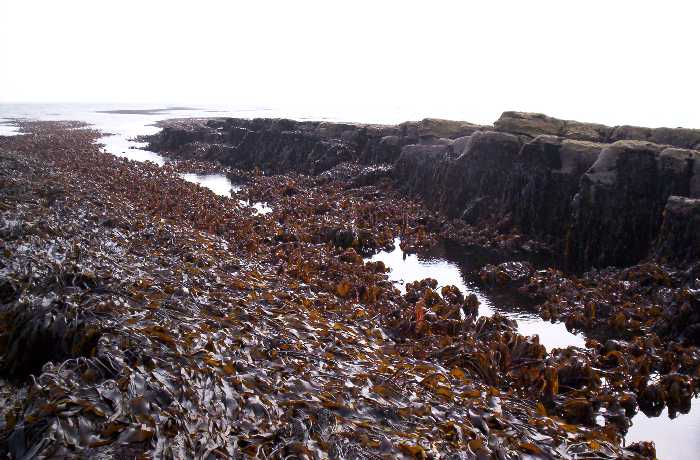
ECOLOGICAL ZONATION
Different ecosystems are to be found at different levels on this (or any other) rocky shore. Ecologists would classify this as an "exposed rocky" section of coast. The "exposed" adjective really applies here only during gales coming in from the east, which are relatively rare when compared with the Atlantic battering suffered by comparable shores on the west coast. But it certainly doesn't benefit from being "sheltered" like some estuaries or sea lochs for example.
The location and range of each identifiable ecosystem here depends not on distance from the shore, not even on depth of water, but on the TIME that each square metre is DRY during each twice-a-day tidal cycle. This being the case it quickly becomes clear that plant and animal communities are different above and below mean (average) sea level - "MSL". Now the range of tides varies with the stage of the month - or fortnight actually. The biggest tides occur when sun and moon are more or less aligned, together or directly opposite one another: so these spring tides happen once a fortnight near full and new moons. Incidentally, by "biggest" we mean the highest high waters together with the lowest low waters. In between times, when sun and moon are at right angles to one another the tides of smallest range are the neap tides. But none of these factors are simple and obvious: it takes a Hydrographer to work out the maths for exact predictions.
The ecology of the top end of the shore is affected both by MHWS, mean high water springs, and EHWS, extreme high water springs. Similarly, those species most likely to suffer severely from even the briefest period of drying are influenced by MLWS, mean low water springs and perhaps even by ELWS, extreme low water springs.
The tidal range at Snook, assumed to be identical to that within Seahouses harbour, is from a high of 5.44 metres above ordnance datum at Newlyn, Cornwall, to 0.27 metres at ELWS, a maximum vertical range of some five and a quarter metres, seventeen feet.
THE SPLASH ZONE
The presence of scurvy grass and thrift amongst the grass immediately above the beach might be attributed to its salty circumstance.
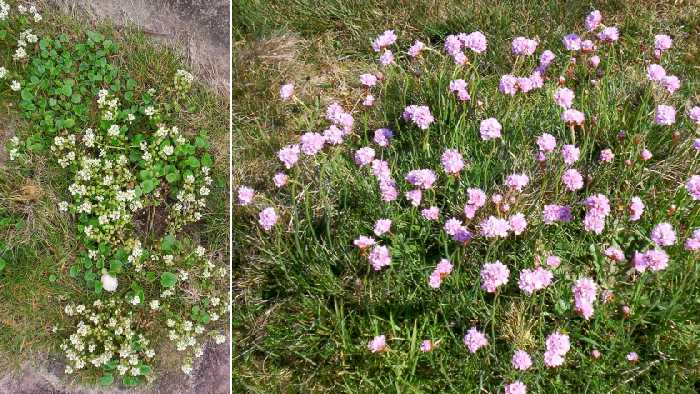
But the highest true indicator of the marine environment is the presence of a slightly sooty-looking layer on the otherwise bare rocks (most clearly over to your left as you face out to sea).
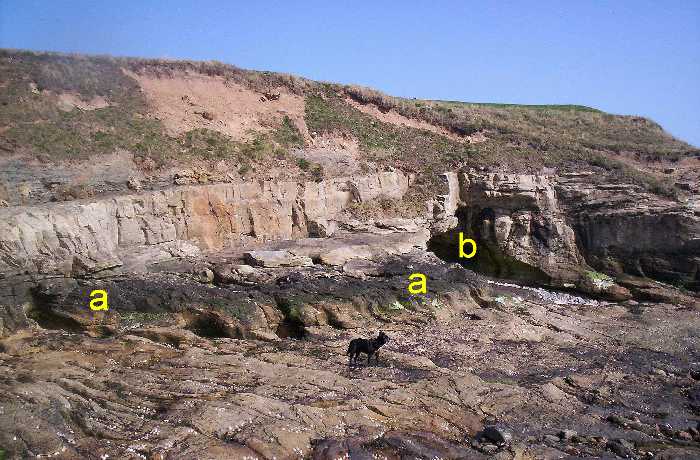
(a) is the splash zone layer, darkened by the extremely tough microscopic lichen Verrucaria maura.
(b) is simply the shadow within the small cave there.
THE UPPER TIDAL ZONE
The most obvious inhabitants of the otherwise bare rocks are the limpets and barnacles. There are several types of limpet to be found around UK shores but the only species present here is the rightly-named common limpet, Patella vulgata. Some congregate in sheltered hollows while others brave total exposure to sun and surf. Any that finally succumb leave behind home scars of their occupation.
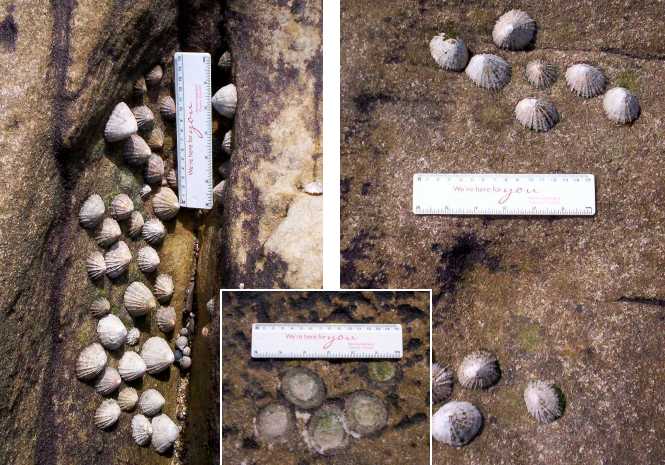
Each animal appears to be a permanent fixture. But it feeds by moving around, 'grazing' on minute algae and lichens on the rocks in its immediate area while it's under water, returning exactly to its home station where its shell forms an almost airtight fit with the rock.
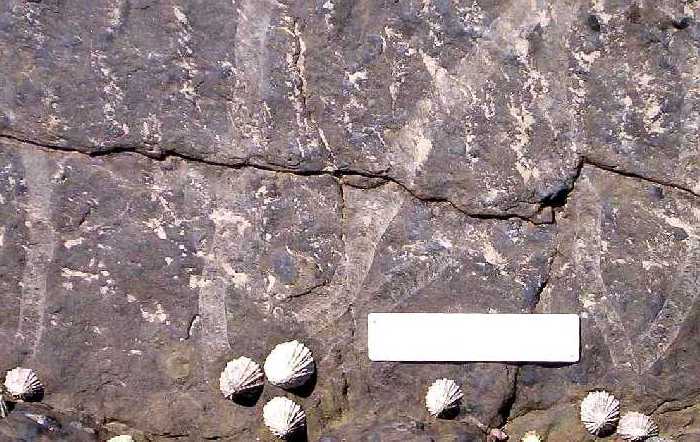
Next most obvious are the millions of barnacles which truly are permanently static once each has found a home for itself. Apparently dead (as indeed some of them are!) they can feed only when covered by the tide, catching microscopic plankton and detritus with nets waved above their openable central plates.
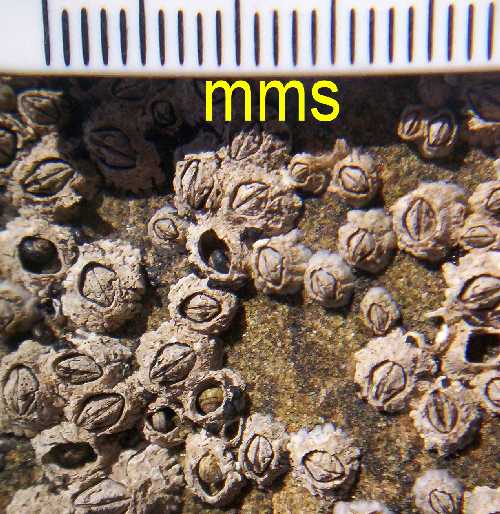
Apart from the encrusting lichens and some microscopic vegetation which nourishes the limpets, the highest obvious plant life consists of the first of the family of "wrack" algae. None of the algae produce flowers: instead they reproduce from enlarged 'conceptacles' towards their tips. Algae come in red, green and brown families: all the wracks, and kelps which we meet lower down, are manifestly browns.
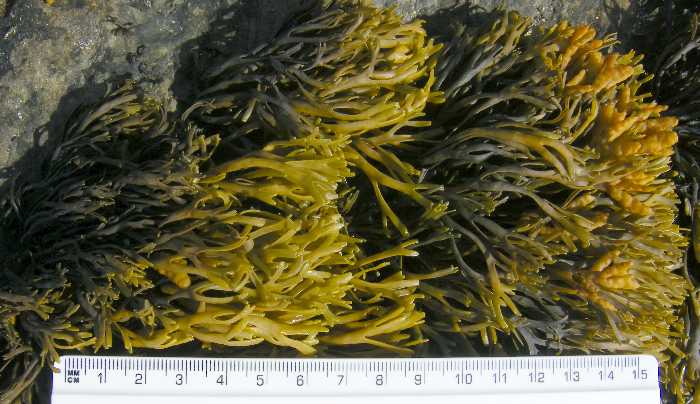
This channelled wrack, Pelvetia canaliculata, is the smallest of the wracks, extending right up to mean high water level. Although evidently very tough it forms only a relatively narrow band: other species can out-compete it wherever conditions are slightly easier - slightly less exposed to prolonged drying. Photographed in late summer, the yellowish swellings on the ends of the fronds on the right contain the male and female 'conceptacle' cavities: the actual reproductive bodies are microscopic.
There are much smaller numbers of green algae. There is usually only one to be seen at this level - gutweed, Ulva (or Enteromorpha) intestinalis, named from its resemblance when floating to small green intestines!
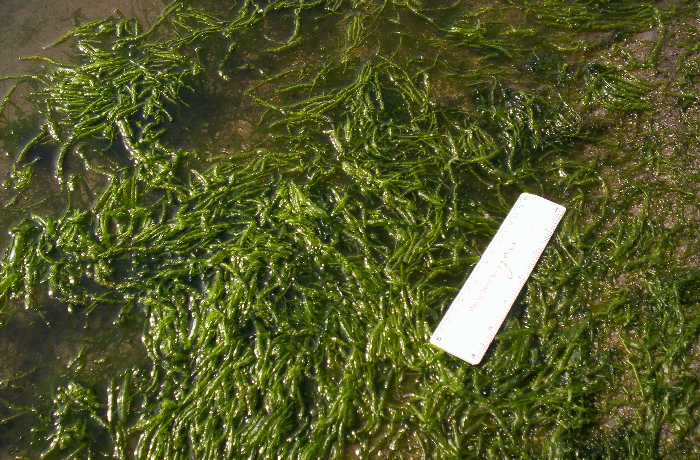
Rough periwinkles, Littorina saxatilis, are to be found anywhere on the upper shore - on drying rocks, in shallow pools, often gathered in large numbers in crevices and hollows as here -
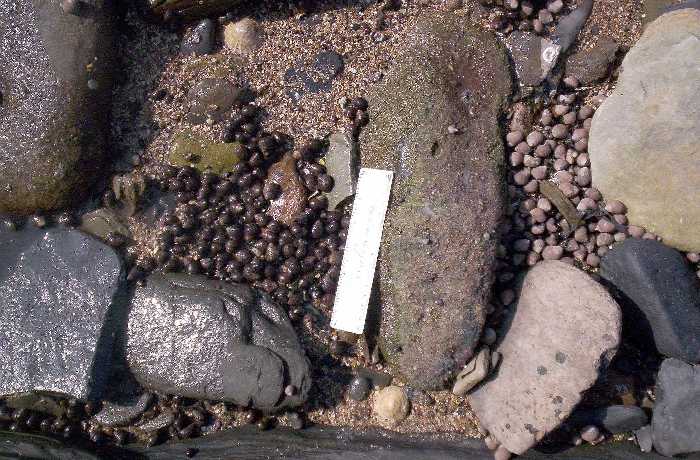
- seen as the tide is coming in to re-wet them from the left.
| An occasional winkle predator, particularly at favourable low water springs, is man! | 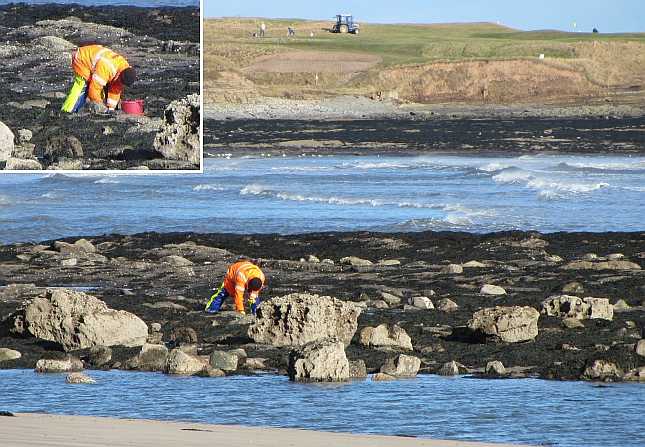 |
The winkles graze on lichens and other vegetable matter in the area, sometimes (albeit rarely) leaving visible tracks of their expeditions.
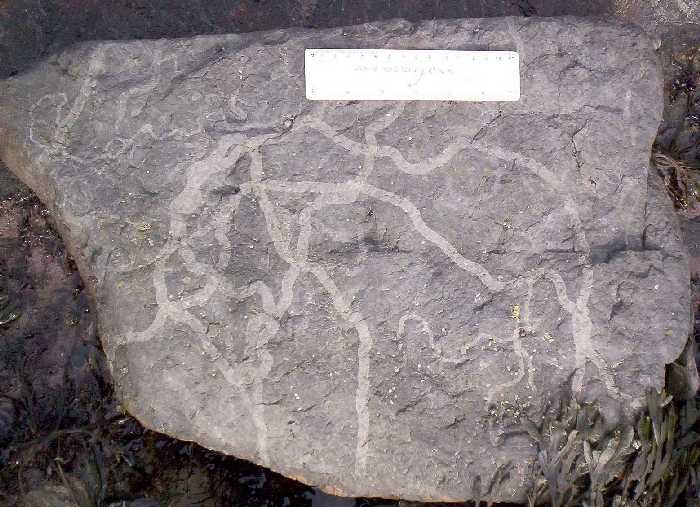
Not all marine lichens share the dull colour of the splash zone. While not covering any large areas, a white lichen, Tephromela (or Lecanora) atra is to be seen on many stones and boulders where they are dry for part of the day.
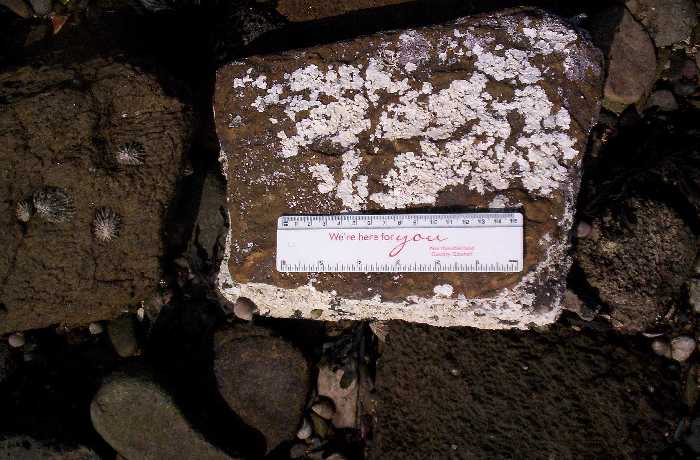
MID-SHORE
It is on the mid-shore that the wracks achieve almost total dominance. These brown algal seaweeds, slimy to the touch and slippery to the feet, can be highly productive and luxuriant despite being exposed to drying-out for anything from a quarter to three-quarters of their day. There are a number of these wracks, mainly Fucus species. Much the toughest, the one that is almost a match for the channelled wrack, Pelvetia, is the spiral wrack, Fucus spiralis. It, on the right below, is larger and more flattened than the channelled wrack on the left.
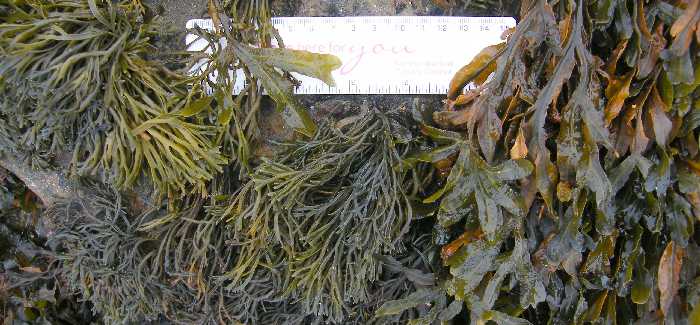
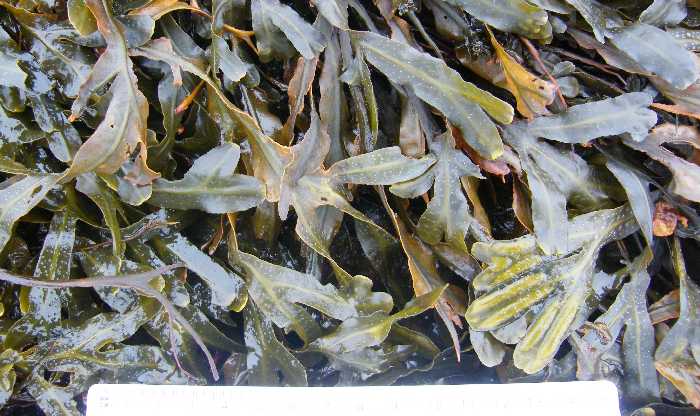
The next Fucus to be met on a journey down-shore is the bladderwrack, Fucus vesiculosus.
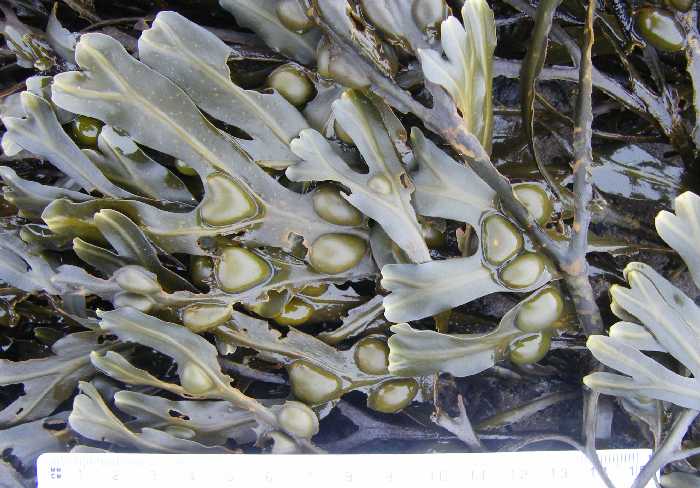
The very characteristic feature, the one that gives this wrack its name, is the presence of the gas-filled bladders which help to keep the seaweed vertical when under water. But they develop only as the plant matures, so spreads of young bladderwrack may in fact be quite bladderless!
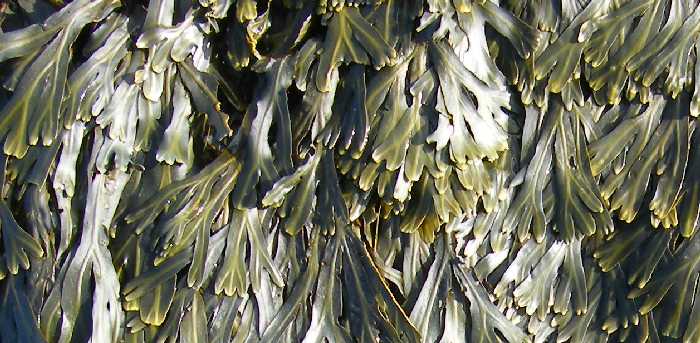
There's another mid-shore wrack which is sometimes found sharing the bladderwrack or lower parts of the shore. But it's not another Fucus. It delights in the name of Ascophyllum nodosum or more commonly 'egg wrack'. Like the bladderwrack it has flotation bladders but as swellings on 'stems' rather than otherwise flat fronds.
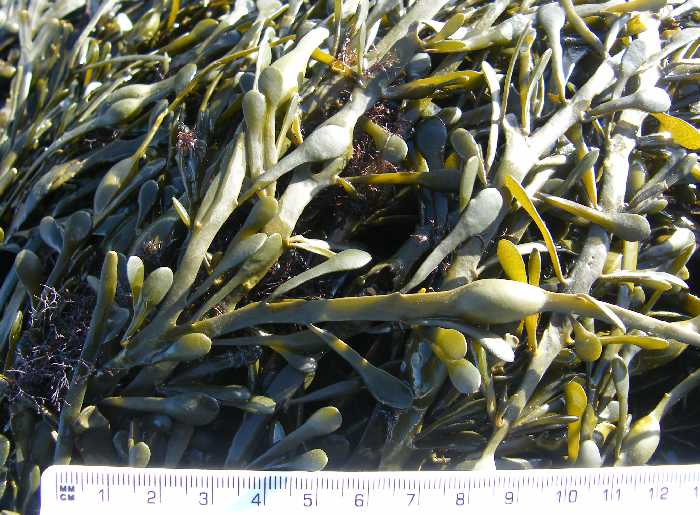
| A filamentous red alga called Polysiphonia lanosa commonly attaches itself to the egg wrack: it is an epiphyte - more a case of piggy-back than of parasite. |  |
The wrack to be found lowest on rocky shores is the saw or toothed wrack, Fucus serratus. It tends to be slightly larger than the other wracks, lying quite flat when out of the water.
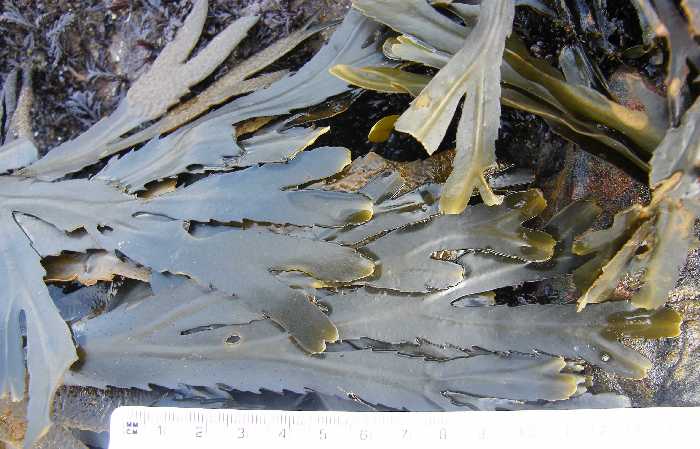
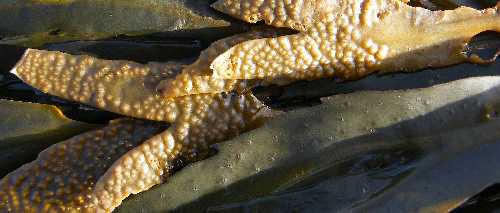 |
It has very characteristic reproductive receptacles in due season. |
| Another piggy-back occupant of the zone is a minute tube-worm that builds coiled chalky tubes glued to the surface of wrack fronds. It gets its nourishment from passing plankton, not from its host. Its name? Spirorbis spirorbis and/or S. rupestrus or even Janua pagenstecheri. | 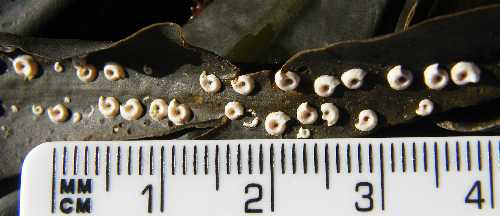 |
Wracks do not have this mid-shore environment entirely to themselves. A smaller colleague may be thought of as sheltering beneath and between the wracks, or as desperately seeking its share of the available light.
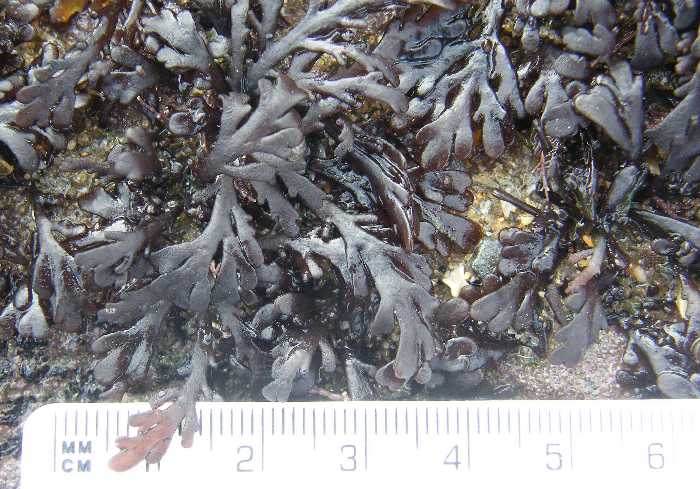
Officially classified as a red seaweed, this pepper dulse, Osmundea (or Laurencia) pinnatifida, can be any colour from this near-black to almost yellow-buff. It is reportedly collected and dried, in both Scotland and the Channel Islands, for use as a spice.
Another red seaweed is recognisable as much with the feet as with the eyes! It is found only in places where sand can wash across rocks. Rhodothamniella (Audouinella) floridula's apparently insignificant mini-fronds trap sand, building up a firm, non-slippery carpet on top of the rock.
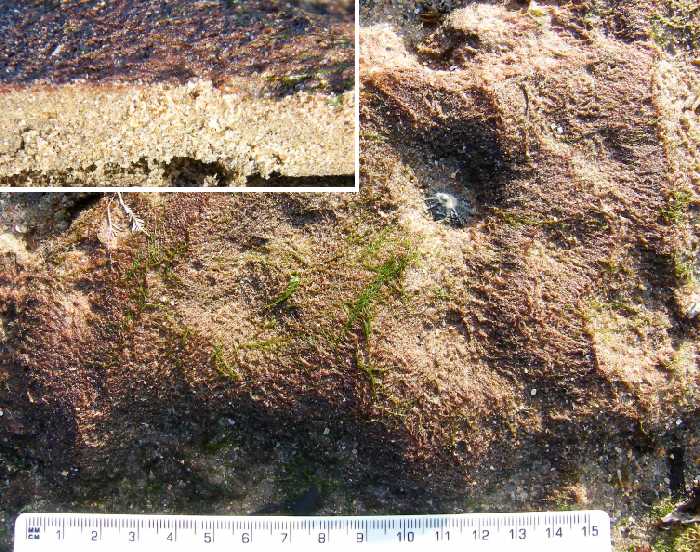
In fact, whether regularly exposed to the air or having the benefit of a tidal pool, wracks are commonly just part - perhaps a dominant constituent - of a plant community, almost certainly with animal denizens of some sort too.
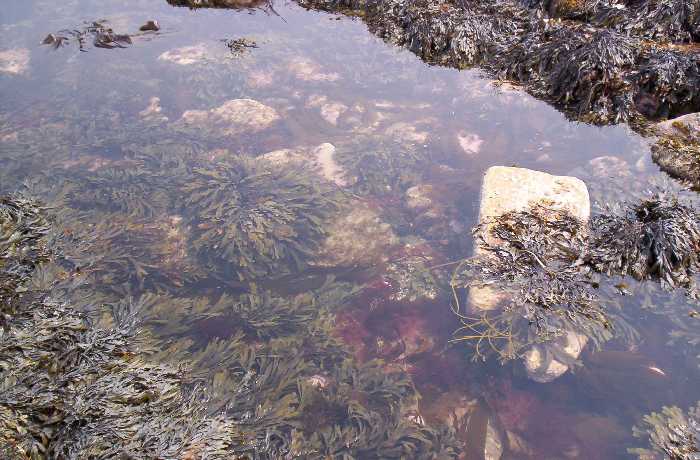
The red tinge in this pool is due mainly to a very ubiquitous red alga called coralweed, Corallina officinalis. It is one of a small group of algae that accumulate lime within their tissues.
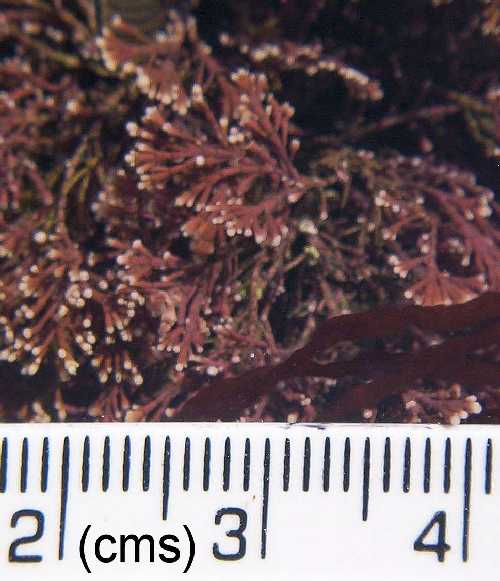
Of course, tidal pools can make up a whole study of their own. But it is unfortunate from the point of view of a website compiler that the vast majority of interesting inhabitants are past masters at (a) hiding by camouflage or (b) hiding under weeds or rocks, or else (c) they are so nearly transparent as to be virtually invisible or (d) they move too fast to be caught even in a photograph. The commonest exceptions have up to 192 stinging tentacles apiece, so they're not worried about being seen! They are the sea anemone (a-nem-on-ee) animals that normally stick to rocks under water but can withstand being exposed by tides. They can withdraw their tentacles altogether: they then look like blobs of coloured jelly.
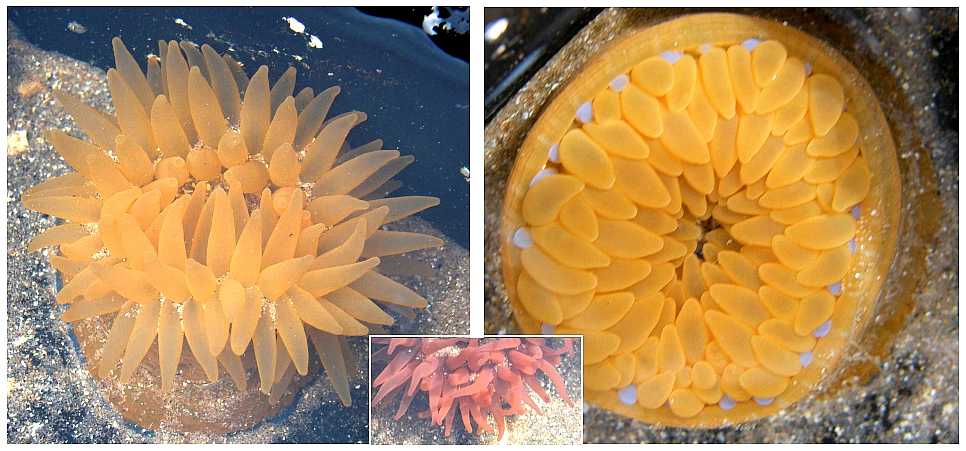
Much the commonest are the beadlet anemones, Actinia equina. They can be up to 5 cms across, individuals varying quite widely in colour as shown here. The two large pictures are of the same creature, on the left with tentacles expanded and on the right showing off its ring of blue spots during the process of withdrawing into itself.
LOWER SHORE
The lower shore remains largely under water throughout periods of neap tides. The depth of water is greater and the periods of exposure considerably reduced compared with those on the higher levels. It is here that larger species of brown algae can develop - the kelps. Commonest by far is the oarweed or tangle, Laminaria digitata. From a holdfast on the rock a long stipe or stalk, oval in cross-section, grows to bear a divided flat lamina. The stipes are bendy, but sufficiently rigid to stick up above the water during low water springs. The apparently indistinguishable companion, Laminaria hyperborea, has stipes that are circular in section, with a relatively rough surface, and if bent over severely they can be snapped.
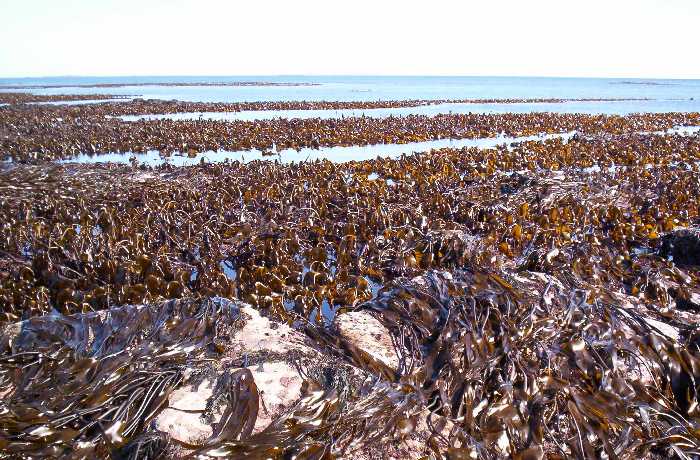
Indeed, that ecosystem is sometimes referred to as a 'laminaria forest', though other species are present too, even including epiphytes growing on the stipes of the laminaria.
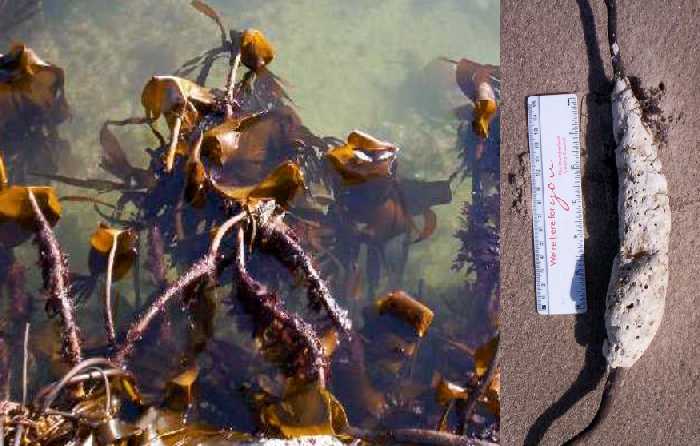
On the left, the red epiphyte is one of a whole group of possible red algae using the laminaria stipes for support. The white sea mat on the right, seen after being stranded ashore, is in fact a cylindrical colony of zooid animals.
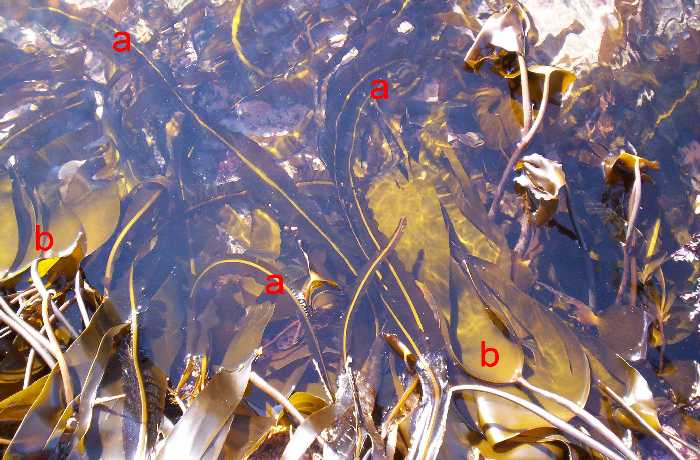
Almost identical in colour to the oarweed (b), dabberlocks (a) (Alaria esculenta) has a ruffled lamina with a mid-rib. In contrast, complementing the big brown algae and colonising spaces between their holdfasts, lesser algae and encrusting lichens occur, as shown below between the cuvie plants, Laminaria hyperborea.
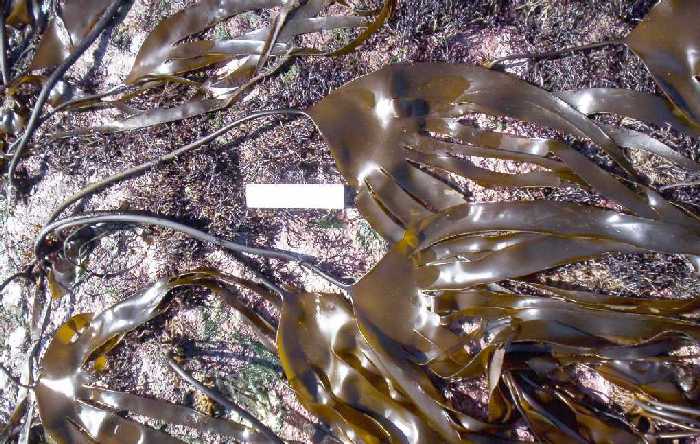
(Just in case you're wondering ... Even the brown seaweeds make use of chlorophyll, the green pigment that enables most land plant leaves to photosynthesise. As brown seaweeds decompose it is fairly common for the dark pigments to degrade first, leaving the chlorophyll to show itself unmasked.)

Seaweeds vary as regards lifetimes, with some of the kelps lasting up to fifteen years. What usually happens in the end is that the holdfasts no longer hold fast: autumn tidal movements and storms tear them free. The outcome is a 'cast' of seaweeds being deposited by the tide, sometimes (depending on wind directions) accumulating to a considerable bulk. The material is all recycled eventually: so much methane is produced during decomposition that thought is being given to its use as a contributor to biofuel production.
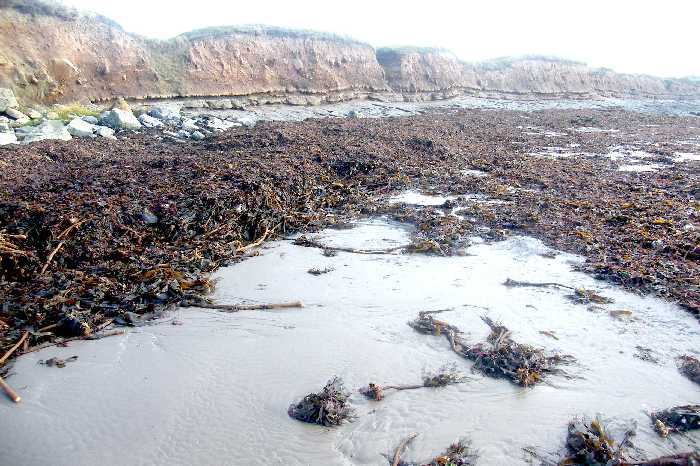
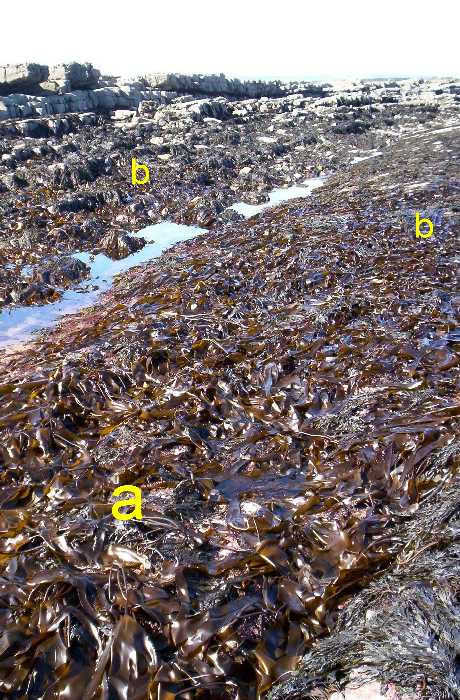 |
[Those exposed rocks over there are nearly all carboniferous limestones from 300m years ago.] Looking up-shore from the low-water end of the path. Higher than the Laminaria kelps (a) are the Fucus wracks (b). |
Largely hidden down below are such things as the pink Corallina we met earlier, with a filamentous green companion alga, Cladophera rupestrus.
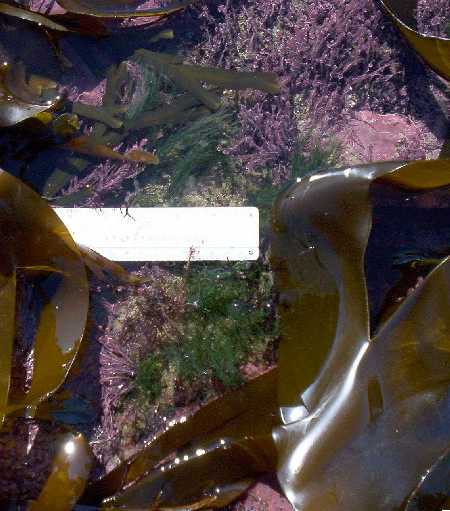
Another of the few green algae is the very thin, apparently flimsy sea lettuce, Ulva lactuca.
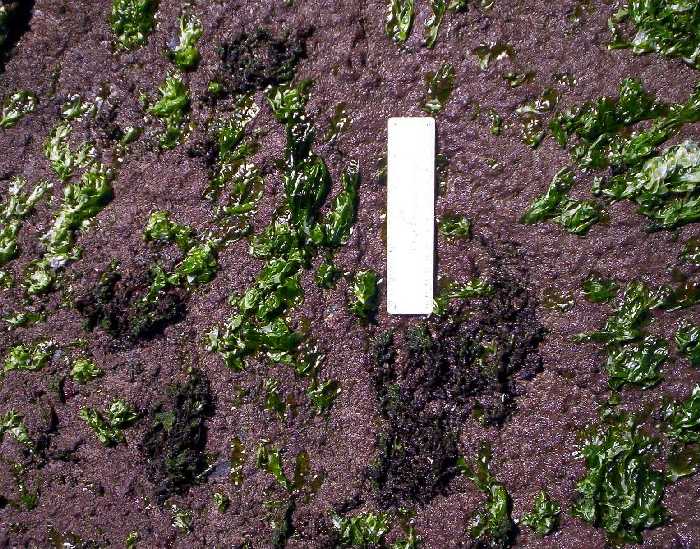
There is not a lot of it in the Snook area but a few patches do occur on the left, fairly well down the path. It looks extremely vulnerable but is actually a very tough plant.
Lesser than the kelps but much more significant than these lowly species, thongweed, Himanthalia elongata, can be dominant in some patches. Its branches can grow to exceed two metres in length, originating and regenerating from characteristic button-shaped initials.
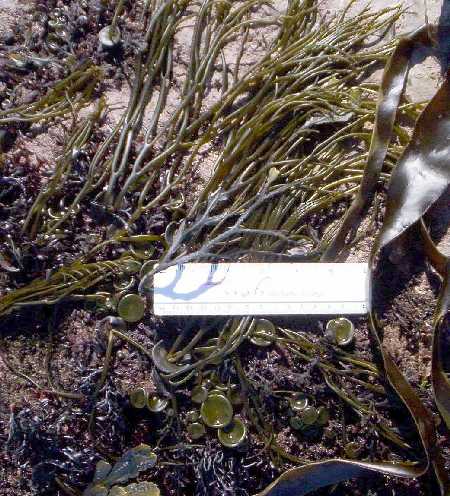
| (a) is the thongweed on a rock and waving in the water. (b) is some fully immersed Laminaria. |
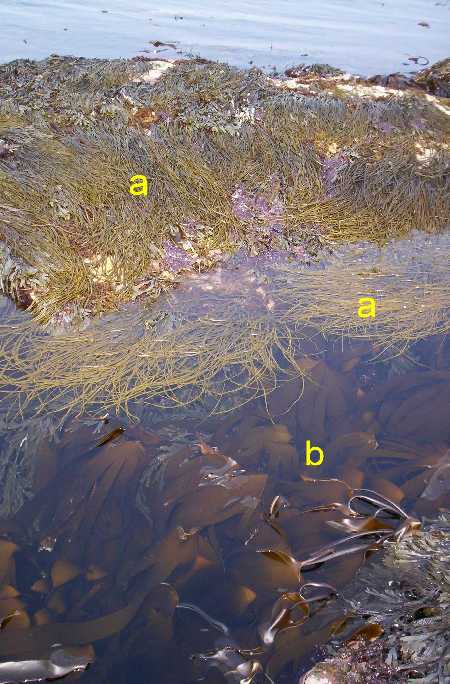 |
Few of the deep-water seaweeds are ever fully exposed, even at extreme low water springs. So in many cases the best sighting occurs after specimens have been washed up. Here is a Laminaria digitata above a Furbelows, Saccorhiza polyschides.
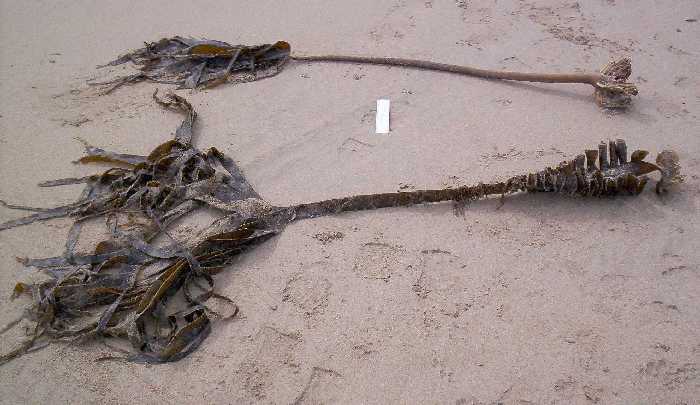
Did you expect to find sponges growing in Northumberland seas? Not, perhaps, very useful for washing the car, but the 'breadcrumb sponge' is a genuine static Poriferal animal - yes, ANIMAL! It forms areas of greenish, brownish, even orange-coloured patches on fairly sheltered rock surfaces anywhere below mid-shore, commonly in kelp areas. Nourishment is obtained mainly from bacteria and other micro-organisms in the seawater passing through its body and out via the volcano-like openings. You can find lots more details if you look up Halichondria panicea.
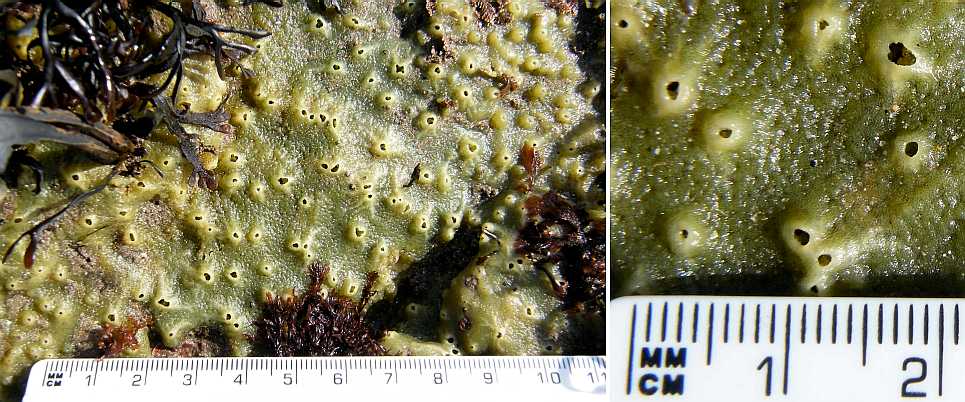
A few limpets are found within these low-water systems. But they may well be a different species from their cousins higher up the shore: known as China limpets, Patella ulyssiponensis, they're a bit lopsided, with a fairly smooth off-centre summit to their shells.
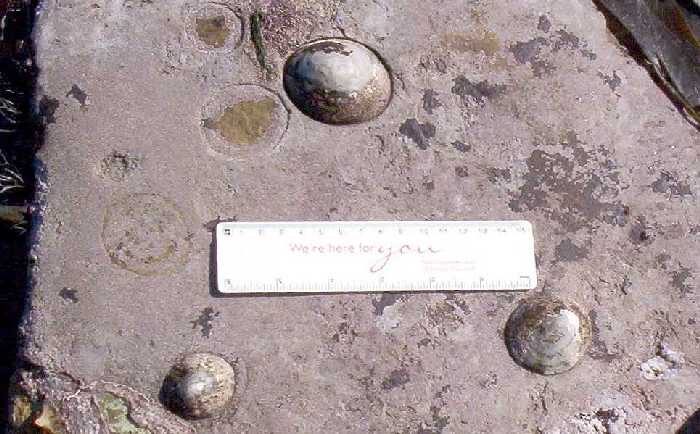
If you're very lucky, or if you have the guidance of a real expert, you might even spot rarities to add yet further interest to your exploration. Included among that category might be 'stalked jellyfish' - small creatures attached to rocks or seaweeds with all the normal characteristics of very small jellyfish but anchored to one place rather than swimming through or drifting with currents of the open sea. (One expert, Dr. Heather Sugden of Newcastle University's School of Marine Science and Technology will be interested in reports of any rarities you find.)
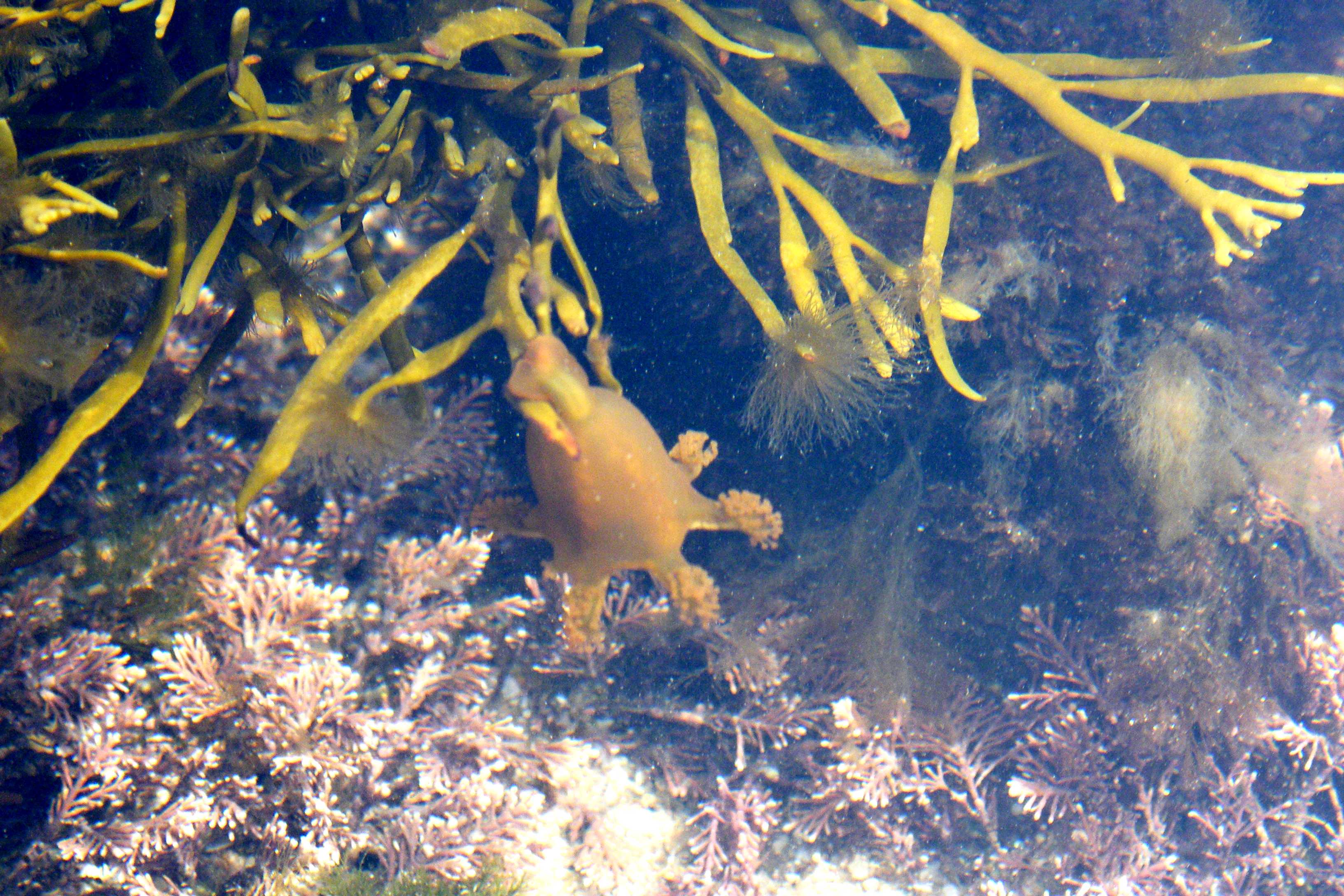 |
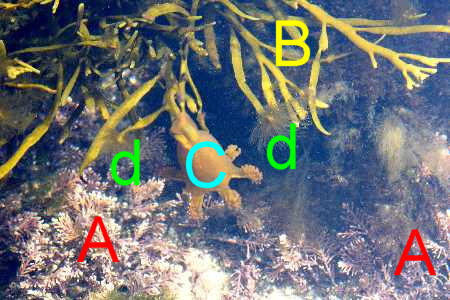 |
C is the downward hanging bell of a stalked jellyfish, Craterolophus convolvulus: it has groups of stinging appendages on the ends of each of the arms fringing the edges of the bell. Unless you've got a huge VDU you're probably seeing it about life size on your screen: the bell is a couple of centimetres long. They occur, usually singly, low down on the shore: because of their situation they can be spotted only in pools where they are not smothered by their host seaweeds.
Yellow B is the brown seaweed known as sea oak - Halidrys siliquosa - which here provides an anchorage for the jellyfish.
The feathery growths at d are of another passenger carried by the main seaweed: they are another seaweed, rejoicing in the generic name Polysiphonia.
A marks small portions of the very common pink miniature forest known as coral weed (Corallina officinalis) which we met earlier.
Another way of increasing your exploration rewards is with a magnifying glass. Take barnacles as a particular example: they're so fascinating that Charles Darwin (yes, the 'Origin of Species' man) studied and wrote seminal monographs about them.
Incredible as it may seem, barnacles mate! Each is equipped with an extendible penis which can reach over to a neighbour: eggs develop into microscopic nauplius larvae, initially on-board so to speak: they then grow and moult repeatedly over winter as part of the plankton. The outcome is, come the following April and May, different, boat-shaped cyprid larvae (> <) that are equipped to swim and explore: they can analyse their surroundings so as to find a suitably textured bare rock - sufficiently close to existing barnacles to facilitate more hanky-panky in due course. |
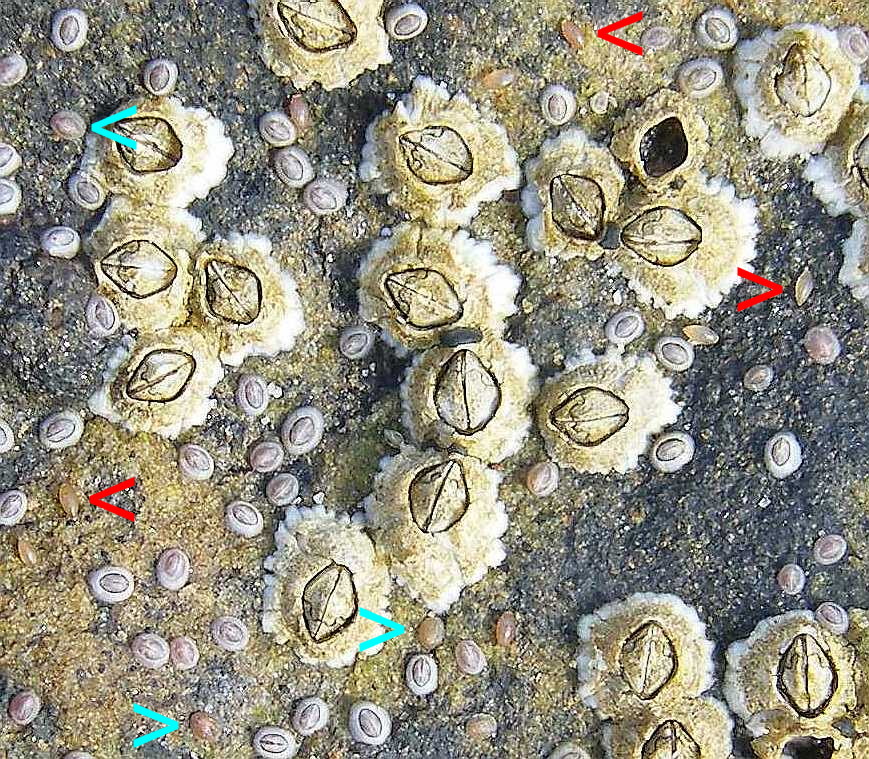 |
OTHER LOCAL INHABITANTS
The myriad animal inhabitants may not show themselves to the casual explorer. They need to be so adept at predator-avoidance that they hide permanently or are well camouflaged, and the majority of movers do so with blinding rapidity or at an almost undetectable snail's-pace. So the chances are that if you do discover a denizen of the deep it is probably a casualty of some sort - perhaps a dead snake pipefish, Entelurus (or Syngnathus) aequoreus, with its characteristic shape and hard-plate exterior that renders it rigid in death.
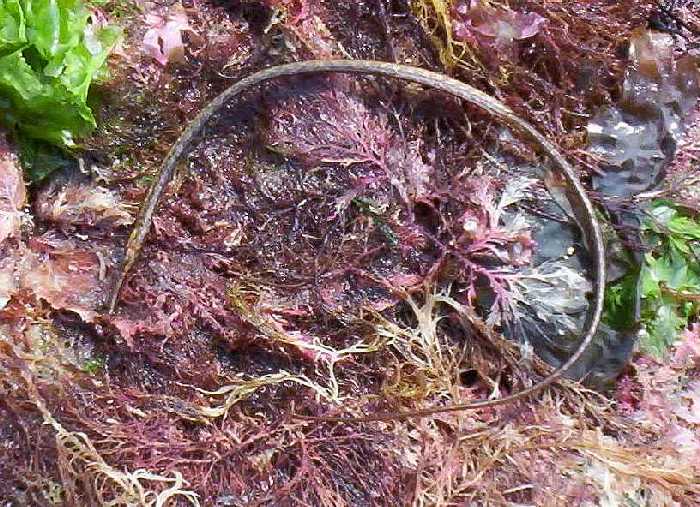
In life it would have been scurrying through the laminaria forest, whereas a healthy octopus would normally be out beyond tidal depths. The wisp of its black ink shows clearly against the white ruler.
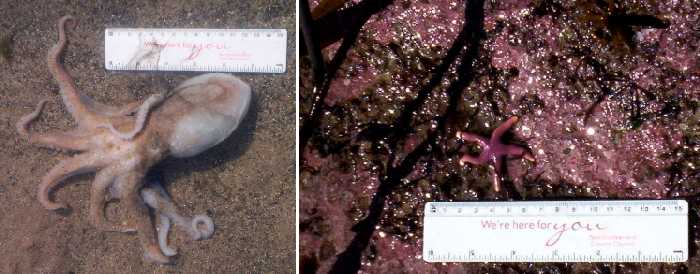
The small starfish might well have been at home, patrolling between the stipes of the kelps. His name is Henry - Bloody Henry, actually - but whether it's Henricia oculata or Henricia sanguinolenta is uncertain.
About the only denizen likely to return your stare of interest would probably be on holiday on the mainland from its normal stomping ground on the Farne Islands, within sight from parts of Snook Point.
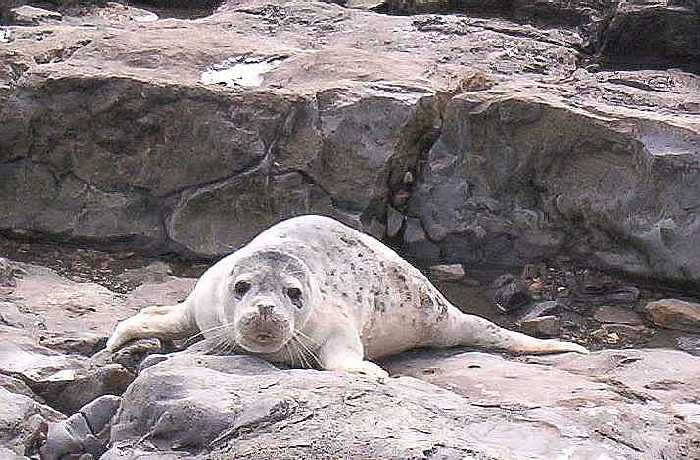
The grey seal looks astounded at being named Halichoerus grypus, but is best left to contemplate his problems without disturbance: it is very unlikely to be a case of unintentional stranding -
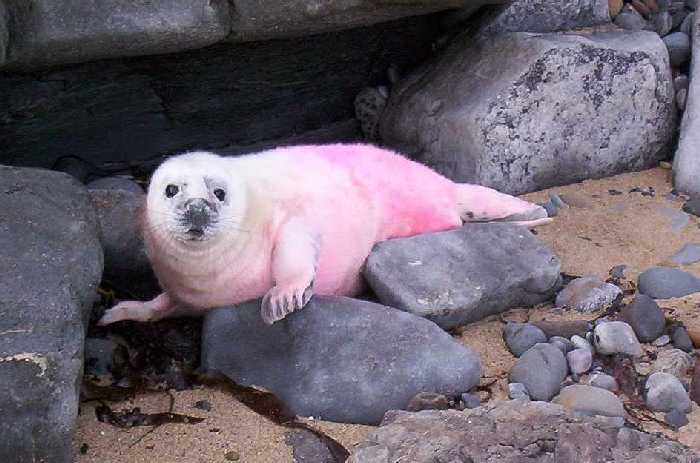
- even if the youngster seems singularly to fail to qualify as a 'grey' seal at all.
At the other end of the range of sizes there are the mini-flora and mini-fauna. Generally known simply as 'pink crust', Lithothamnion glaciale can be found on many patches of what would otherwise be bare rock, usually down below mid-tide levels.
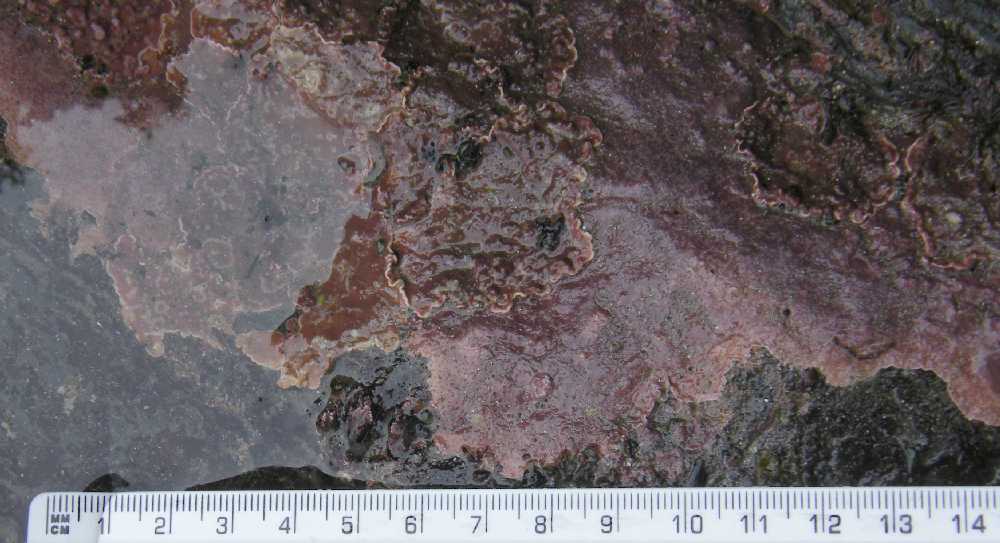
It's actually a red alga. It grows initially like a thin paint-like deposit, later forming more irregular layering. Amazingly, the same organism can also take on a more conventional seaweed form, when it is know as Maerl.
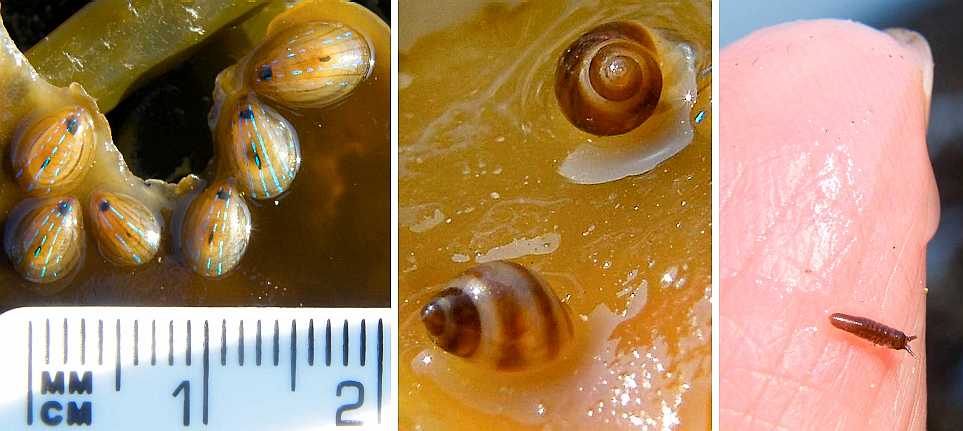
Beasties down at the millimetre scale are very easily found by any interested investigator. All these specimens were samples of multitudes occurring on the tough blades of Laminaria kelp, towards the lowest parts of the shore. The iridescent blue-rayed limpets (Helcion pellucidum recently changed to Patella pellucida) can occur singly or in groups, alone or with companion species. Of a similar size, slightly smaller, the banded chink shells (Lacuna vincta) are probably the commonest of a number of different species of snails within the ecosystem. Those were easy to find and not too difficult to photograph. Moving with frustrating rapidity at times, a variety of isopods live out their lives withstanding the churning of kelp bed waters. The active specimen that climbed onto my finger was almost certainly an Ideotea, perhaps I. neglecta or I. granulosa.
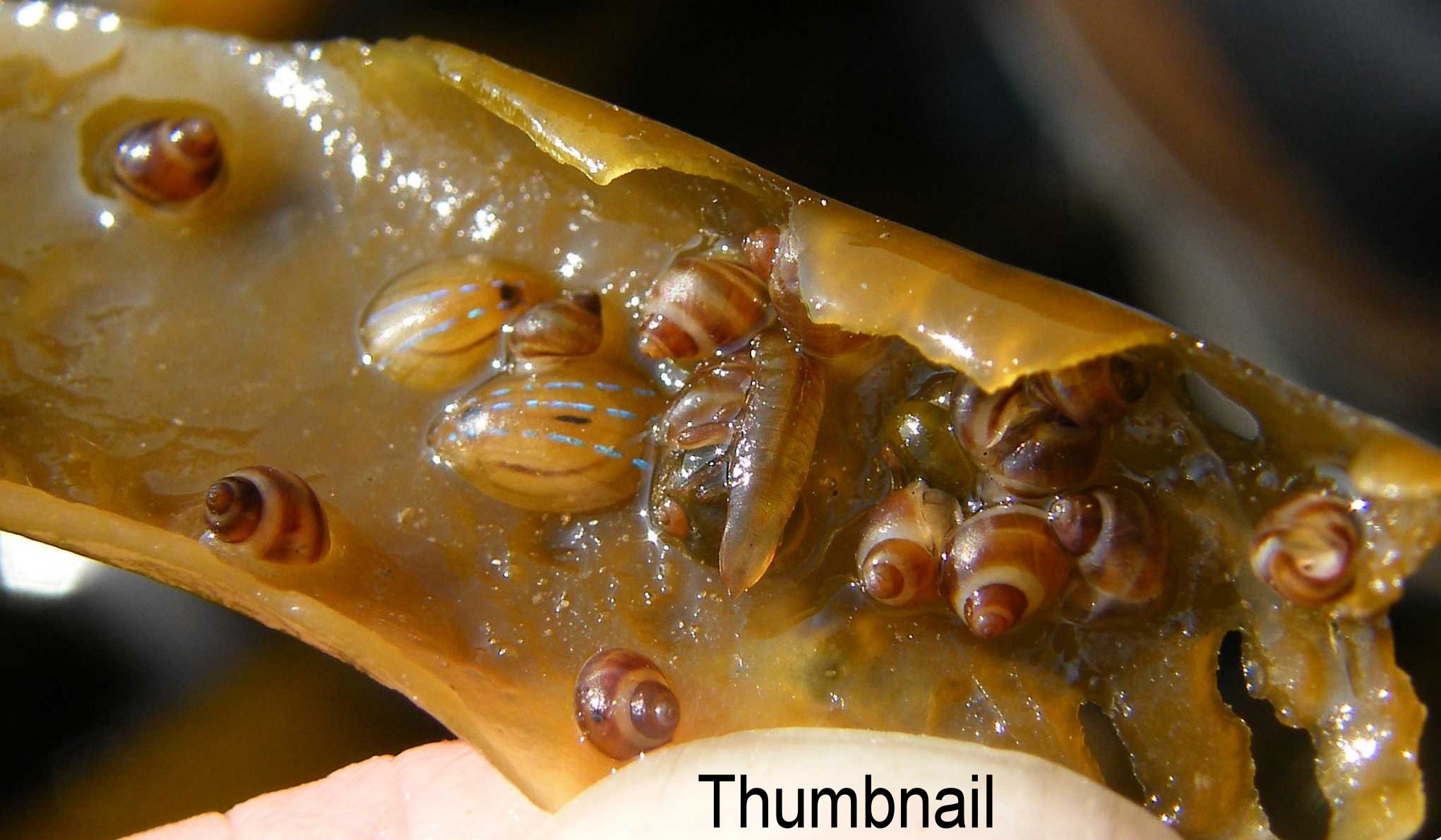
A favoured resting place is to be found wherever the tatty end of a Laminaria blade rolls up on itself, affording some minimal degree of shelter. When unrolled, this specimen was found to include the familiar blue-rayed limpets and banded chink shells. Across the centre, a slightly larger isopod is clambering over what may be common flat periwinkles, Littorina obtusata.
... AND THE REST ...
Thanks are due to marine biologist Dr Heather Sugden for assistance is checking the technical content of this web page. As mentioned earlier, shore zonation is made up of a series of overlapping ecosystems. Each ecosystem includes a wider range of species than have been shown here. In particular, there are many more seaweeds especially on the lower shore and further out into 24-hour water, and positively huge numbers of animals, less obvious than the seals and snails, more significant than the native gulls. The internet provides vast databases of all these inhabitants.
The following might provide suitable starting points for enquiries:
www.theseashore.org.uk
www.marlin.ac.uk/lzspecies.php
marinespecies.org
|
HOME page
Location
Routes
Street plan
Attractions
Visit
Photo album
Walks to/from Sands Dunes Rocks Community Directory Trades Directory |